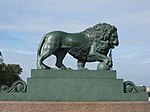Admiralty Embankment

The Admiralty Embankment (Russian: Адмиралтейская набережная (Admiralteyskaya Naberezhnaya)) or Admiralty Quay is a street along the Neva River in Central Saint Petersburg, named after the Admiralty Board. Between 1919 and 1944 the street was known as Roshal Embankment, named after the revolutionary S. G. Roshal. The Admiralty Embankment was constructed in 1763 to 1767, by the engineers V. M. Karlowicz and S. S. Selyavionov. The street has no other buildings than the Admiralty and the Bronze Horseman. The street begins at the Decembrists Square, where the English Embankment becomes the Admiralty Embankment. The street ends at the Palace Bridge, where it becomes the Palace Embankment. The Admiralty Embankment is home to the Admiralty building and the Bronze Horseman, it has also a wonderful view of the Neva and the Saint Petersburg State University is just across the Neva.
Excerpt from the Wikipedia article Admiralty Embankment (License: CC BY-SA 3.0, Authors, Images).Admiralty Embankment
Адмиралтейская набережная, Saint Petersburg
Geographical coordinates (GPS) Address External links Nearby Places Show on map
Geographical coordinates (GPS)
| Latitude | Longitude |
|---|---|
| N 59.9384 ° | E 30.3055 ° |
Address
Адмиралтейская набережная
Адмиралтейская набережная
191011 Saint Petersburg (Адмиралтейский округ)
Saint Petersburg, Russia
Open on Google Maps










